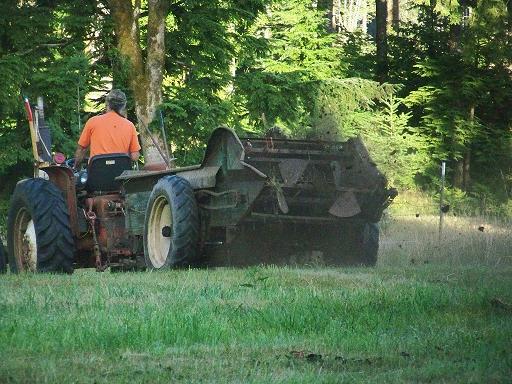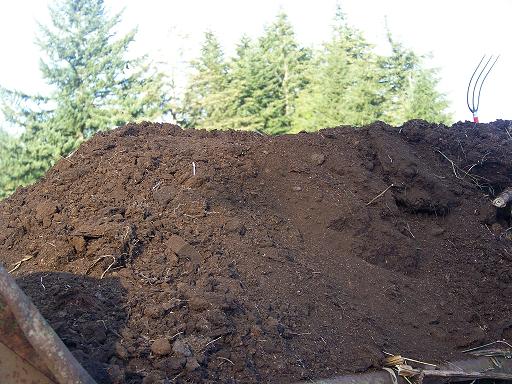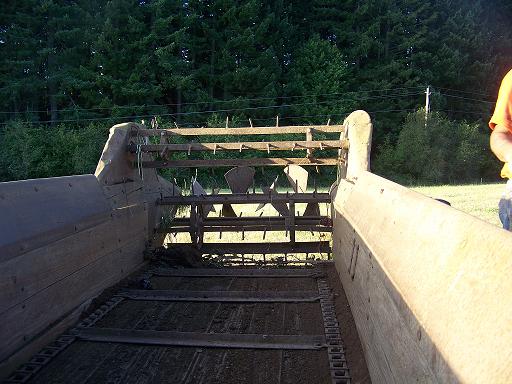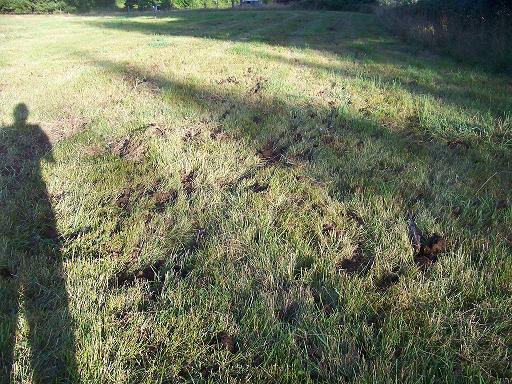Spreading the wealth
We fertilize our hayfields with our composted manure after cutting the hay in order to stimulate growth when the fall rains come. The hay fields are tender at this time and grazing them to spread manure directly from the cattle would do more harm than good. Fertilizing with compost or manure stimulates the biological action of the soil, applying chemical fertilizers does not. It seems if you break it down, the conventional way of farming puts all the emphasis on the immediate crop with no regards to the ongoing health of the soil for the next crop and the next. Whereas biological farming methods take future crops into consideration. With hay, nitrogen fertilizers are applied in the spring to stimulate growth and it does get you growth, but I am not necessarily looking for tonnage, or having the tallest hay, I am looking for quality and a variety of plants in our hay. Another tongue waving tip: graze your hayfield in the spring once, and stimulate that soil and new growth. By doing that you may be making hay later than your neighbors, but gee, do I want to have the first hay in the barn, or do I want to have hay that didn’t get rained on. By grazing you’re still getting your second “cutting” that will win you accolades at the coffee shop and you will be benefitting your stock in innumerable ways. However, this method is a little hard to explain at the coffee shop. 😉
Black gold! It’s hard to believe farmers who think manure is a liability… .
Clean as a whistle.
Food for the soul.






We spread ours on pasture that is close. Mostly tame pasture too as the native grass doesn’t like it as much.
LOL, our furthest pasture is probably like your close pasture! No wide open spaces here! I bet you use a PTO spreader too, instead of messing around with the ground drive?
I love that pitchfork peeking over the top of the pile! And, lordy, what a huge pile that is! Whew, that’s a lot of work, particularly loading it into the spreader. So, is that mini mountain of black gold just, um, cow manure, or does it contain other stuff, too? I kept humming that song, Circle of Life, as I read this! 🙂 Did you spread that entire pile? Not to sound gross, but is that a years worth of accumulation? Does any find its way to your garden? Nice shadow in that last photo, too!
Paula, I would not dare to ask a certain someone to load that manure spreader with a pitchfork! I would be in the doghouse then 🙂
The pitchfork is for clearing out a clog if there is one. We deep bed the cows in the winter in a feeding shed, some winters the manure/bedding pack is 4 feet deep. The cows stay comfy and dry, and kindly leave their manure for us in exchange for hay. Then the shed is cleaned out (with a loader) and the bedding pack is stacked to compost a year before spreading on the fields. I get first choice for the gardens 🙂 It takes about a week to spread the entire bounty, and about a week to clean out the feeding sheds.
Shadow and photos supplied by Ruthless!
Funny thing about the loader – it belongs to a friend and we trade beef for the occasional use of the machine. Just after they picked up their beef, they both told us separately that they were getting a divorce. (Both have been married several times already!) Selfish folk that we are – our first thoughts were who gets custody of the loader and the side of beef? 🙂 Update to all that – they are giving it a go because it would cost too much to get divorced! Phew!!
Soon we will have more say and control over our hay fields so these posts come in handy. Thanks for sharing your knowledge!
Thanks Kim!
I remember reading in the horse magazines how you didn’t want manure spread over the hay fields as that would spread disease. Propaganda b.s.!! I’ll take manure over petroleum based fertilizers any day of the week as I now understand that those very artificial fertilizers end up making a plethora of minerals unavailable to the plants which then leaves the animals with mineral deficiency’s which then attracts parasites and disease. 1 + 1 = 2 Very simple.
I also remember reading in my school books that farming is killing the soil and that it will take many thousands of years for the soil to restore itself after man has gone. I finally understand that that is all about the modern methods of farming and not the old tried and true methods that enrich and build the soil as you are doing. Keep up the good work. Our earth needs more farmers like you!!
Doris, if it wasn’t so sad, it would be funny. How could the manure spread disease unless the animals were sick. The bad thing about the chemical fertilizers are that they kill all the soil life and then the soil can’t properly break down any organic matter, so the soil never does function properly and more and more fertilizers and chemicals are needed just to get a crop.
A friend of ours was disgusted that we were using horse stable cleanings as part of our bedding plan – his son shook his head and told us we would be bringing disease and parasites to our farm from the horse stable. We tried to explain that parasites are species specific and that we weren’t using it in the horse stall, but for the cattle and chickens. Mostly shavings and hardly any horse manure, and the funny thing is the horse stable people haul it away and do nothing to put anything on their pasture. They feed their horses year round. We figure if they want to haul their fertility to us for free, we are more than happy to oblige.
Just seeing that gorgeous composted mountain of poo makes my heart beat a little faster…Jack and I laugh when we say things like that, but it’s so true. That unwanted horse manure has done wonders for us in an area that before was just concrete-like hardpan, and if we had a field, it surely would be getting applications as needed however we could manage. I see your pictures of those pastures getting fed and I think “wow, feast for the grass!” Constant kudos to you for helping me better understand the grass-growing connection as the core element in having the best for livestock and us humans, Nita 🙂
Robbyn
Hi just a question on variety of plants that you are looking for. As of right now our land is leased to a conventional farmer that sprays fertilizer and spreads lime every spring.
We are hopefully going to take the farm back over in the next year or two. How long would you estimate that it will take for the native plant life to start growing again. The fields are currently just fescue and a few weeds. I have been looking for more info on restoration of these fields but keep coming up short. Thanks for any help, love the blog!
Cody, if you can get some animals grazing, (cows are the most helpful maybe in conjunction with sheep) it will return faster than if you follow the conventional advice to reseed, etc. There’s a good chance the plant diversity you seek is already there, it just needs some stimulation from grazers and their fertilization additions to make it bloom. Another thing that helps speed it along if you aren’t quite ready to start grazing is to mow it several times a year to mimic the effect of an animal grazing, it’s not the same thing but it does serve the purpose of shearing the plant which in turn makes the plant slough roots. The litter is plant and soil critter food, and the mowing will thicken the stand. Nothing works overnight, but at least you would be doing something 🙂